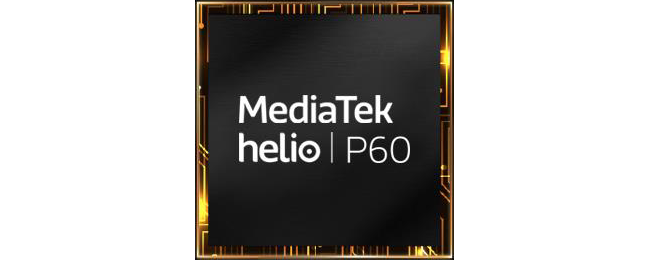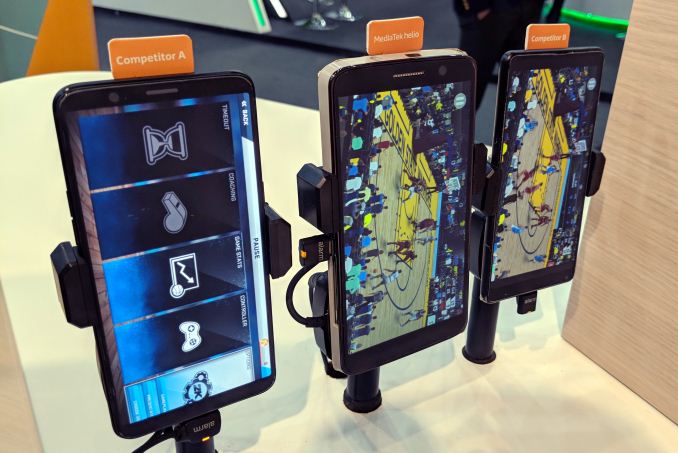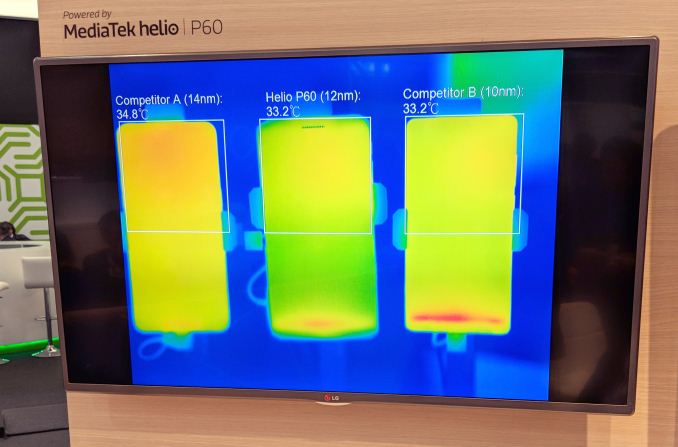MediaTek Announces New Premium Helio P60 SoC
by Andrei Frumusanu on March 1, 2018 9:30 AM EST- Posted in
- Smartphones
- Arm
- Mobile
- Trade Shows
- MediaTek
- Mali
- Helio
- MWC 2018
- P60
- A73
- A53
- ARM Cortex

BARCELONA, ESP – Earlier this week MediaTek announced a new entry in the Helio SoC line-up, the Helio P60. The P60 comes with a strategy change for MediaTek as the company is doubling down on the super-midrange “premium” category and expanding that range into multiple sub-tiers.
The strategy change comes from market and lack of success in the high-end Helio X series. Last year’s Helio X30 had only a few design wins and was relatively late to market. MediaTek seems to have had a string of bad luck with the X20 and X30 as both came on either problematic or very delayed manufacturing process nodes which lost them important design wins. As more vendors switch over to custom designs in the high-end and Qualcomm puts more pressure with competitive designs, MediaTek decided to put a hold on the X series for now and concentrate in the range where it is very successful, the P series.
The this new segmentation means that the P60 doesn’t position itself as direct successor to late last year’s P23 and P30 but rather as a tier above them, hence the naming scheme.
| MediaTek Current P-Series | |||
| SoC | Helio P23 | Helio P30 | Helio P60 |
| CPU | 4x Cortex A53 @ 2.3GHz 4x Cortex A53 @ 1.65GHz |
4x Cortex A53 @ 2.3GHz 4x Cortex A53 @ 1.65GHz |
4x Cortex A73 @ 2.0GHz 4x Cortex A53 @ 2.0GHz |
| GPU | Mali G71MP2 @ 770MHz | Mali G71MP2 @ 900MHz | Mali G72MP3 @ 800MHz |
| APU / NPU / AI Proc. / Neural IP | - | 2x 140GMACs | |
| Memory | 1x 32bit LPDDR3 @ 933MHz 2x 16bit LPDDR4X @1500MHz |
2x 16bit LPDDR4X @ 1600MHz | 1x 32bit LPDDR3 @ 933MHz 2x 16bit LPDDR4X @ 1800MHz |
| ISP/Camera | 1x 24MP or 2x 13MP | 1x 25 MP or 2x 16MP | 1x 32MP or 2x 20+16MP |
| Encode/ Decode |
2160p30 H.264 | 2160p30 H.264 & HEVC | 2160p30 H.264 & HEVC |
| Integrated Modem | Category 6 DL = 300Mbps 3x20MHz CA, 64-QAM UL = 50Mbps 64-QAM |
Category 7/13 DL = 300Mbps 3x20MHz CA, 64-QAM UL = 150Mbps 2x20MHz CA,64-QAM |
Category 7/13 DL = 300Mbps 3x20MHz CA, 64-QAM UL = 150Mbps 2x20MHz CA,64-QAM |
| Mfc. Process | 16FFC | 16FFC | 12FFC |
The P60 is the first SoC in the P-lineup to employ “big” microarchitecture cores as it uses 4x Cortex A73 cores at up to 2.0GHz – a significant performance boost in performance over the P23 and P30’s A53 cores. The efficiency cores are naturally still Cortex A53’s and they run at the same 2.0GHz frequency as the performance cluster.
On the GPU side we see an update in the IP as MediaTek in turn transitions from G71 to G72. The P60 uses a G72MP3 running at up to 800MHz and promises a 25% gaming efficiency boost (at up to 70% higher GPU performance).


Snapdragon 660 vs Helio P60 vs Snapdragon 835 Thermal Comparison @ MWC2018
The P60 is the first mobile SoC to come manufactured on TSMC’s new 12nm 12FFC process node. 12FFC is a shrink of 16FFC and uses the same tools – it’s a cost effective alternative to the more expensive 10FF process which requires quad-patterning. While 12FFC does not quite achieve the die size reduction that 10FF would, it’s extremely competitive in terms of power characteristics and reaches near the same efficiency. I asked MediaTek about the company process roadmap plan and they will focus exclusively on 12FFC for 2018 and have no plans for further 10nm silicon. The next generation will jump directly to 7nm in mid 2019 (after other vendors) when mass production will have reached mature and cost-effective levels.
The P60 is the first SoC to bring dedicated neural network accelerators into the mid-range. MediaTek’s denomination for such IP is APU (AI Processing Unit) so that’s yet another term added to the varied basket of abbreviations from different companies. MediaTek wouldn’t disclose the IP provider but say’s it’s a dual-core implementation offering 2x140GMACs. MediaTek will offer a custom software stack called NeuroPilot which will be compatible with Google’s NN API and frameworks such as TensorFlow, TF Lite, Caffe and Caffe2.
The modem subsystem remains the same as on the Helio P30 – it supports LTE up to Category 7 with 3x20MHz CA and 300Mbps download speeds and Category 13 with 2x20MHz CA for up to 150Mbps upload speeds.
The Helio P60 is in production now and we should see consumer smartphones with the chipset available starting early Q2 2018.










74 Comments
View All Comments
agoyal - Thursday, March 1, 2018 - link
Can someone list phones using P20and P30 series...I don’t recall seeing any main vendors using themleo_sk - Thursday, March 1, 2018 - link
Basically a snapdragon 660 competitor in cpu power but lagging in graphics and modem. They are avoiding a direct clash with snapdragon 635, which would be present in most midrangers, unless they are pricing it that competitvelyname99 - Thursday, March 1, 2018 - link
Uhthe super-midrange “premium” category
WTF???
serendip - Thursday, March 1, 2018 - link
Well, considering that Qualcomm just came up with the 700 series as a rebrand for its 66x chips, it's possible these companies see a segment opportunity just below flagships. Not everyone needs or can afford a Snapdragon 845. Efficiency is still a big issue with Mediatek chips though, their GPU and overall SoC designs use a lot more power than comparable Qualcomm chips.name99 - Saturday, March 3, 2018 - link
midrange I accept.super-midrange I'm willing to accept.
But "super-midrange premium" is in the realm of lunacy
HardwareDufus - Friday, March 2, 2018 - link
"super-midrange “premium” category"I couldn't agree with you more.... absolutely meaningless distinction.... do 'Super', 'MidRange' and 'Premium' even belong in the same descriptor set??
I miss the days of Cheap, Good, Better, Best. There! We're done....
jjj - Thursday, March 1, 2018 - link
This would be nice at 18$ or about, with P40 bellow it vs SD636 and above it, the P70 maybe at around 25% higher perf.Overall not sure if MTK did enough with A73 on 12nm when Qualcomm seems to be going with A75 on 10nm, with a slight delay i suppose. Not a problematic difference in the end, as long as there are no unexpected issues.
The so called AI accelerator is supposed to be Cadence Vision P6.
Do you have any clue on die size, we rarely get such data for mid range SoCs.
Should be a good year for mid range, too bad that DRAM prices are ruining the party.
ZolaIII - Friday, March 2, 2018 - link
MTK is trying to kick in in cheap SoC market range so neither A75 which is 50% bigger than A73 & there for cry out for more advanced lithography nor 10 nm FinFET that they already had bad experience with that is mostly considered as a half node and pricier have much sense.Can you confirm that its Tensilica Vision P6 DSP?
That would actually make my day as it's much more superior than QDSP (especially cut down version of it) would also mean that the most of the code is possible to share between Samsung, HiSilicon and now MTK as they all share the same DSP all do probably in different cluster configurations. It's one of my favourite designs & scalable up to MP4 so very capable in both AI and media - vision tasks.
jjj - Friday, March 2, 2018 - link
Qualcomm will likely have A75 at up to 2GHz with their 700 series, not higher to protect the SD845. A P70 with A73 at 2.5GHz on 12nm is competitive enough but won't lead in perf and efficiency. Mediatek is not being as aggressive as Qualcomm and they should know better by now as Qualcomm has been very aggressive for a couple of years. Mediatek will keep getting burned if they don't step up, they can't afford to behave like the tiny guy, they are not. Qualcomm used to get outfoxed by pretty much everybody else but they are not leaving any room for that anymore.Yeah there is the SD636 and maybe the 660 stay above it (the 636 is a downclocked 660) so they got that part covered but the 670&friends, AKA SD7XX, should be A75 on 10nm.
I'm pretty certain about Vision P6 and it's interesting that the X30 uses Vision P5 for 70 GMAC.
ZolaIII - Friday, March 2, 2018 - link
& so did the previous Kirin. S636 isn't downclocked S660 as the GPU is 1/3rd cut off or better say the old A506 on proteins (higher clock & XDDR 4 mem controller). An old question; an chicken or an egg. Arm said how A75's can give peek performance gain over A73 at around 25% but how sustainable performance will be about the same. So why would someone as MTK go for it? Sure DinamIQ which ain't compatible (or they say so) with older A73's. DinamIQ reduces (35~40% even 55% in best case scenario) up migration times (if core's are in active idle state) which in real workloads adds very little to the performance but it will significantly rise what user's call "snappines" & we call response time. This will indeed make a difference to how most folks will feel it. I know you are a fun of the MTK, you always whose but let's face it they simply ain't doing things bright. They or for that matter anyone else can only win it by playing smart & focusing on real user needs (similar how AMD done it before & it's probably doing it again). I hope we will soon see some DinamIQ cluster product's containing only two A75's & four A55's an P6 (or it's successor) MP2 & GT8540 GPU on the TSMC 12nm or GF 22nm FD-SOI naturally all reasonable clocked (1.8~2 GHz CPU which is sustainable for two A75's & 600~700 MHz for GPU...). It doesn't matter that it won't be ground braking, it doesn't matter that SoC would cost 35~40 $ it would still be much cheaper than the same one on 10 or 7nm (until EUV doesn't become a real standard). That's the way to win the war by making it solid, mass & still affordable. I don't expect MTK to deliver that, HiSilicon had some ups and downs but they are far from mature behaviour so they certainly won't deliver it, Samsung could but they won't as they most of all value their profits, QC won't as it's to long in the leader's position & also like to change a little extra, PNX really could but they have no interest in mobile market at all & besides will probably become the part of QC anyway, old Broadcomm is gone, Texas Instruments bailed down long ago and has no intention of getting back. So basically nothing will change. Me by if we got an hyper competition with Chinese jumping in something could be different but US is blocking it. Sorry for the long one, anyway it's just my perspective of things as they are now.Best regards.